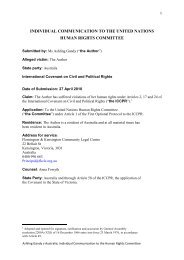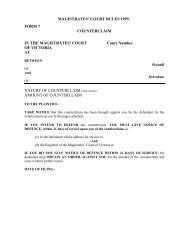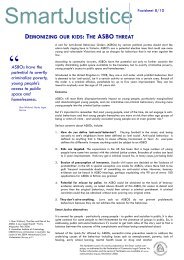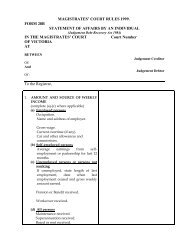Reducing Ethnic Profiling in the European Union - Open Society ...
Reducing Ethnic Profiling in the European Union - Open Society ...
Reducing Ethnic Profiling in the European Union - Open Society ...
- No tags were found...
Create successful ePaper yourself
Turn your PDF publications into a flip-book with our unique Google optimized e-Paper software.
The United Nations, <strong>the</strong> Council of Europe, and <strong>the</strong> <strong>European</strong> Commission havehighlighted ethnic profil<strong>in</strong>g as a particular area of concern with respect to discrim<strong>in</strong>atorypolic<strong>in</strong>g practices. International human rights monitor<strong>in</strong>g bodies have likewisehighlighted ethnic profil<strong>in</strong>g as an area of concern.The first step <strong>in</strong> address<strong>in</strong>g ethnic profil<strong>in</strong>g is to admit its existence and recognizeits discrim<strong>in</strong>atory nature. The next step is decid<strong>in</strong>g what to do about it. The f<strong>in</strong>al stepis implement<strong>in</strong>g new policies and practices that reduce ethnic profil<strong>in</strong>g and replace itwith more reasoned and effective procedures. <strong>Reduc<strong>in</strong>g</strong> <strong>Ethnic</strong> <strong>Profil<strong>in</strong>g</strong> <strong>in</strong> <strong>the</strong> <strong>European</strong><strong>Union</strong> aims to assist <strong>in</strong> this process by offer<strong>in</strong>g diagnostic questions, provid<strong>in</strong>g ideasand models of proven good practice, and identify<strong>in</strong>g challenges and impediments toreform. It is <strong>the</strong> result of a thorough review of exist<strong>in</strong>g laws and relevant academicliterature, field test<strong>in</strong>g of specific reforms, and extensive <strong>in</strong>teractions with state authorities,law enforcement agencies, civil society organizations, and local ethnic m<strong>in</strong>oritycommunities across <strong>the</strong> EU.<strong>Ethnic</strong> profil<strong>in</strong>g is not an easy issue to resolve. Law enforcement agencies mayfeel that a focus on ethnic profil<strong>in</strong>g unfairly s<strong>in</strong>gles <strong>the</strong>m out as racist. For ethnicm<strong>in</strong>ority persons and communities, discussions of ethnic profil<strong>in</strong>g highlight stereotypesabout m<strong>in</strong>orities and offend<strong>in</strong>g.But while discussions of discrim<strong>in</strong>ation and racism are never easy, reduc<strong>in</strong>g ethnicprofil<strong>in</strong>g can be a w<strong>in</strong>-w<strong>in</strong> proposition that benefits law enforcement agencies and<strong>the</strong> many communities <strong>the</strong>y serve. Both research and first-hand experience—exemplified<strong>in</strong> <strong>the</strong> case studies throughout this handbook—demonstrate that adopt<strong>in</strong>g goodpractices not only supports fairer polic<strong>in</strong>g but can also improve <strong>the</strong> effectiveness of lawenforcement.This handbook provides a wide-rang<strong>in</strong>g review of current efforts to reduce ethnicprofil<strong>in</strong>g and support non-discrim<strong>in</strong>atory law enforcement. Its numerous case studiesexam<strong>in</strong>e: non-discrim<strong>in</strong>atory standards established <strong>in</strong> legal <strong>in</strong>struments and operationalguidel<strong>in</strong>es, research and monitor<strong>in</strong>g methodologies, <strong>in</strong>stitutional practices that createnon-discrim<strong>in</strong>atory workplaces that reflect <strong>the</strong> societies <strong>the</strong>y serve, and models of communityoutreach and engagement. The case studies and explanatory text aim to provideclear and practical support to all those seek<strong>in</strong>g to understand <strong>the</strong> dynamics and reduce<strong>the</strong> frequency of ethnic profil<strong>in</strong>g. Taken toge<strong>the</strong>r, <strong>the</strong>y offer a holistic approach to lawenforcement that does not discrim<strong>in</strong>ate.Beg<strong>in</strong>n<strong>in</strong>g with a def<strong>in</strong>ition of ethnic profil<strong>in</strong>g, this handbook exam<strong>in</strong>es <strong>the</strong> needfor a holistic approach to reduc<strong>in</strong>g ethnic profil<strong>in</strong>g, <strong>the</strong>n looks at <strong>the</strong> legal standards and<strong>in</strong>stitutional policies for address<strong>in</strong>g ethnic profil<strong>in</strong>g, as well as <strong>the</strong> oversight bodies andcompla<strong>in</strong>ts mechanisms relevant to <strong>the</strong> issue. Subsequent chapters explore <strong>the</strong> use ofethnicity <strong>in</strong> data ga<strong>the</strong>r<strong>in</strong>g by law enforcement, strategies for reduc<strong>in</strong>g disproportionalityand improv<strong>in</strong>g <strong>the</strong> quality of contacts between police and community members, and14 INTRODUCTION
















